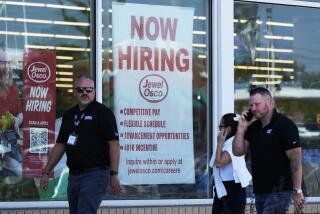VIEW FROM WASHINGTON / JAMES RISEN : Maybe, Just Maybe, American Workers Can Stage a Comeback
- Share via
A quiet sense of anxiety has enveloped the American workplace.
Convinced that job security is a thing of the past, U.S. workers are learning to live with a cold fact of life: The balance of power between management and labor has shifted in management’s favor.
But the roots of the new anxiety among American workers reach deeper. The globalization of the U.S. economy, the widening pay gap between highly educated workers and those with few skills, and the long, slow shift from labor-intensive manufacturing to service-based industries are all conspiring against working-class Americans.
Economists and sociologists have worried these issues to death for a generation. Yet it is only in the 1990s that they finally seem to be hitting home. Today, the gap between high-paid workers and their low-wage counterparts is wider in the United States than anywhere else in the industrialized world.
Labor Secretary Robert B. Reich has coined the phrase “the anxious class” to describe those Americans suffering with these economic crosscurrents. Newsweek magazine uses an excessively pretentious phrase--”the overclass”--to describe the flip side, those benefiting from rapid economic change in a fiercely competitive, education-based meritocracy.
But some economists still wonder whether these harsh trends have staying power.
Is the American economy, they ask, really becoming a more hostile thing?
Maybe, just maybe, the American worker can make a comeback.
To be sure, the economic data seems to support those who worry that the economy is moving against American workers in some fundamental--and perhaps permanent--ways.
Average wages, adjusted for inflation, have been steadily declining while labor productivity--one of the best measures of corporate efficiency--has been steadily rising. The gap between the two has widened by at least two percentage points for two straight years.
That has been great news for American business, making the United States increasingly attractive to foreign investment. U.S. News & World Report says, for instance, that corporate profits, measured as a percentage of national economic output, are now back up to the levels of the boom years of the 1950s and ‘60s.
Yet rising productivity at a time of falling real wages means that Americans are working harder--often at two jobs instead of one--but getting less for their labor.
Still, some labor economists are not willing to proclaim that these trends reflect a permanent shift against the American worker.
Sustained economic growth, coupled with increased American competitiveness, could put strong upward pressure on wages over the next few years. New information technologies could lead to new employment possibilities and greater job mobility. And dissatisfaction with insensitive management tactics could lead to a rebound in unionism.
Many economists in the Clinton Administration are not yet willing to write off the future. Some of them point out that we have seen these conditions before.
“What we are seeing today is not unprecedented,” said one Administration economist who asked not to be identified by name. “In the past, there have been many times when we have experienced gaps between the growth of productivity and the growth of wages that were similar to what we see now.”
Administration economists have discovered a trend that could allay concerns about whether the United States is undergoing a long-term transformation.
Here is the calculation: During 15% of all the two-year periods over the last 30 years, the United States has experienced gaps between productivity and wage growth that were as large as or larger than the current spread of two percentage points.
“It’s clear we have had gaps of this magnitude in the past,” the economist said. “But in the long haul, the two have always tended to move together.”
That means that eventually, wages tend to catch up with productivity, as periods of rapid productivity growth are followed by periods of accelerating wages.
In addition, he noted, the economic data tends to overstate the real gap between productivity and wages. The government doesn’t use the same inflation-adjustment formulas to adjust productivity as it does to figure inflation’s impact on wage growth. The consumer price index is used to adjust wages, while the GDP deflator, a different measure of inflation, is used to adjust productivity for inflation.
“That makes the gap between productivity and wages look bigger than it really is,” the economist said.
All this suggests that declarations of a national crisis are premature. “It is too early tell if what we are seeing is a structural shift in the economy or a more transitory one,” he said.
But even Administration economists acknowledge that wages are still not showing many signs of recovery. In late July, for example, the government reported that median weekly earnings, adjusted for inflation, fell nearly 1% from the second quarter of 1994 to the second quarter of 1995.
Meanwhile, the job quality index, a measure of trends in wages and compensation compiled by an economist at Harvard University, showed its second-smallest monthly rise in two years in June. And this year’s employment gains, the survey found, are coming mostly in low-wage industries.
“Median wages have been growing slowly mainly because people at the bottom of the income range are doing poorly while people at the top have had real gains,” noted Alan Krueger, the Labor Department’s chief economist.
“That has been the main story on wages for the last 15 years, and it is still the main story. And I think there is a fair amount of evidence that the driving forces are the globalization of the economy, the decline of unionization and worsening gaps in education.”
Still, that doesn’t mean that the historic link between productivity and wages--one that has kept the two more or less in line--has now been broken.
“I still think it is premature to say this is a structural shift” in the relationship between productivity and wages, the Administration economist said. “But certainly it’s one we have to keep an eye on.”
More to Read
Inside the business of entertainment
The Wide Shot brings you news, analysis and insights on everything from streaming wars to production — and what it all means for the future.
You may occasionally receive promotional content from the Los Angeles Times.










